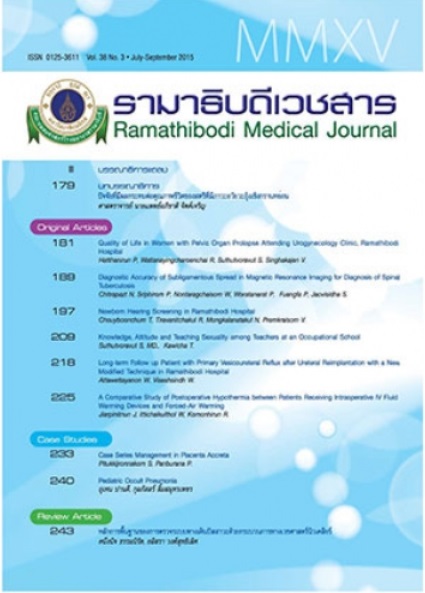Newborn Hearing Screening in Ramathibodi Hospital
Main Article Content
Abstract
The purposes of this research were to study the outcome of newborn hearing screening services at Ramathibodi Hospital. The retrospective research was applied. The population of this research consisted of newborns who were born during July 1, 2012 to June 30, 2013 with follow up until 3 months of age. Data were analyzed by using descriptive Statistics. The results of the research were as follows: 99.1% of all live births were screened. 5% of these live birth did not pass (refer rate) the screening, 89.1% of the babies which did not pass the screening to follow up at the first visit in 1 month of age. 80.2% of those babies who did not pass the screening were evaluated for hearing diagnosis before 3 month of age. These results could be used as baseline information in order to develop newborn hearing screening services to develop more effective implementation and policy program for hearing program.
Article Details
References
Polpathapee S, Kasemkosin N. Children-hearing-problems. The development of rehabilitation for children with disabilitie. GreenPrint, Bangkok; 1999:217-27.
Gilbert RH, Carol AK, Annie GS. Hearing Sounds and Silences. In: Mark L. Batshaw, ed. Children with disabilities. 5th ed. Washington, D.C.: Paul H. Brooks Publishing co.; 2002:193-227.
Yoshinaga-Itano C, Apuzzo ML. The development of deaf and hard of hearing children identified early through the high-risk registry. Am Ann Deaf. 1998;143(5):416-24.
Yoshinaga-Itano C, Coulter D, Thomson V. The Colorado Newborn Hearing Screening Project: effects on speech and language development for children with hearing loss. J Perinatol. 2000;20(8 Pt 2):S132-7.
Joint Committee on Infant Hearing. Year 2000 position statement: principles and guidelines for early hearing detection and intervention. Pediatrics. 2000:106;798-817.
Joint Committee on Infant Hearing. Year 2007 position statement: principles and guidelines for early hearing detection and intervention programs. Pediatrics. 2007:120;898-817.
Banrord JD. A neonatal hearing screening: a step towords better services for children and fanrilies for children and fanrilies. Br J. Audiol. 1998;32:1-6.
Jariengprasert C, Sriwanyong S, Kasernsuwan L, Supapannachart S. Early identification of hearing loss in high risk newborns and young children by using otoacoustic emissions (OAES): a comparison study with auditory brain stem response (ABR). Asia Pacific J Speech Language Hearing. 2002;7:1-9.
Betty RV, Lisa MC, Patricia EM, Kristen L. The Rhode Island Hearing Assessment Program: Experience with statewide hearing screening (1993-1996). Pediatrics. 1988;133:353-7.
Jariengprasert C, Lertsukprasert K, Kasemsuwan L, Nuntnarumit P. Newborn Hearing. Screening with otoacoustic Emissions at Ramathibodi Hospital. The Royal College of Otolaryngologists-Head and Neck Surgeons of Thailand. 2003;4:27-41.
Cheng-Yu Lin, Chi-Yuan Huang, Chun-Yu Lin, Yi-Hui Lin, Jiunn-Liang Wu. Community-based newborn hearing screening program in Taiwan. Int J Pediatr Otorhinolaryngol. 2004;68:185-9.
Martines F, Porrello M, Ferrara M, Martines M, Martines E. Newborn hearing screening project using transient evoked otoacoustic emissions: Western Sicily experience. Int J Pediatr Otorhinolaryngol. 2007;71:107-12.
Timruangvej A. High risk infant hearing screening at Roi - Et Hospital. Khon Kaen Medical Journal. 2007;31:165-74.
Szyfter W, Wróbel M, Radziszewska-Konopka M, Szyfter-Harris J, Karlik M. Polish universal neonatalhearing screening program-4-year experience (2003-2006). Int J Pediatr Otorhinolaryngol. 2008;72:1783-7.
Olanwanicha W. Newborn hearing screening using otoacoustic emissions at Buriram Hospital. Medical Journal of Srisaket Surin Buriram Hospitals. 2011;26:285-94.
Doyle KJ, Rodgers P, Fujikawa S, Newman E. External and middle ear effects on infant hearing screening test results. Arch Otolaryngol-Head Neck Surg. 2000;122:477-81.
Lin HC1, Shu MT, Lee KS, et al. Comparison of hearing screening programs between one step with transient evoked otoacoustic emissions (TEOAE) and two steps with TEOAE and automated auditory brainstem response. Laryngoscope. 2005;115:1957-62.
Lin HC1, Shu MT, Lee KS, Lin HY, Lin G. Reducing false positives in newborn hearing screening program: how and why. Otol Neurotol. 2007;28(6):788-92.
Benito-Orejas JI, Ramírez B, Morais D, Almaraz A, Fernández-Calvo JL. Comparison of two-step transient evoked otoacoustic emissions (TEOAE) and automated auditory brainstem response (AABR) for universal newborn hearing screening programs. Int J Pediatr Otorhinolaryngol. 2008;72:1193-201. doi:10.1016/j.ijporl.2008.04.011.
Thawin J, Tiravanitchakul R, Limrungsikul A, U Udomsubpayakul. Incident of sensorineural hearing loss newborn at Ramathibodi Hospital. The Royal College of Otolaryngologists-Head and Neck Surgeons of Thailand. 2549;7:85-9.
